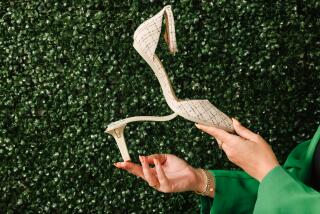FASHION : Flip-Flops Make Fast Tracks to Top
- Share via
If there was such a thing as a sound track that goes with the Fourth of July weekend it would have to include the slappity-flap of flip-flops hitting the pavement.
Perhaps you know them by another name; beach sandals, slaps, slides, thongs, flops, go-aheads and the official Customs Department designation--zories. No matter the regional nomenclature, almost everyone has had a personal encounter with this summer staple.
If you experienced your first pair in the ‘50s, consider yourself lucky. They were probably made entirely of spun sheet rubber. They were comfortable, durable and their best feature was that they cost less than a dollar.
By the ‘60s they had undergone a chemical re-composition. The soles were made of ethylene vinyl acetate (EVA), a man-made, foamlike substance, and the straps were made of plastic. Sure, the price had come down, to as low as 39 cents a pair in some cases. But the workmanship was dreadful, the plastic ate away at the foam, and the first time any stress was put on the plugs they self-destructed. The toe piece would come flipping out and you were left with a flat flop. For many people it was the first and last time they ever donned a pair.
They were too good a concept though to be left languishing on the back of a pharmacy shelf. New materials have been tried and the original rubber versions have also been revived. Today the selection is once again durable, comfortable and, this summer in particular, extremely colorful. Naturally the price has gone up, but most models are less than $20.
Chip Rowland went back to the basics and is the only manufacturer that he knows of who still makes the all-rubber version. At $6.95 a pair, he says his Chippa Slippas will last at least two to three years for average folks, 12 months on a dedicated surfer. Even purists such as Rowland have succumbed to the neon-bright trend in footgear. Top-of-the-line Slippas with tri-color decks and glow-in-the-dark straps go for $10 to $12 a pair.
Another die-hard flip-flop manufacturer is Jay (“call me Sparky”) Longley of Rainbow Sandals. He entered the business in 1975 when slaps were going for $12 a pair; now his top out at $15. There are Rainbow customers so devoted to their sandals that they send them back for resoling.
“I swear,” Longley said, “we resole them. We’ve even had customers send them back for new heels, because their dog chewed them up.”
Flip-flops suffer as no other shoes do. They get abandoned or stolen on the beach. Dogs love to give them a gnaw. And they seem to have a propensity for hurling themselves out of car windows. Flip-flop fatalities, say the manufacturers, are a very common occurrence.
Antoinette Rummel and John Amsterdam of Neet Feet are the thong cubists. They have taken the basic design and done a geometric rendition with die-cut inlays.
For ladies who find flip-flops just too pedestrian, Ken Girouard makes a decorative version that would thrill even Carmen Miranda. His basic flip-flops are covered in plastic fruit and vegetables. Some even do the day-into-evening routine with pearl adornments. Fruit Flops are at the couture end of the zorie scale at $35 to $45 a pair.






